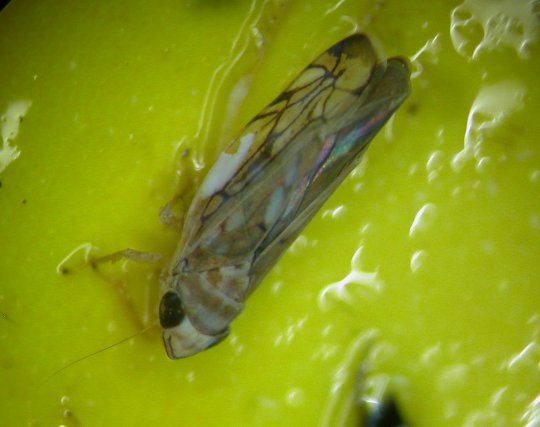Flavescence dorée (FD) carried by the grapevine leafhopper (Scaphoideus titanus) is a serious disease, classified as one of the yellowing diseases of grapevines detected in the 1950s in France. Caused by a phytoplasma that is classified as a quarantine organism, its main vector is a parasitic leafhopper which transmits the phytoplasma by feeding on vines. Flavescence dorée is one of the most damaging diseases for European vineyards and can have a severe impact, such as yield losses or plant dieback and significant economic consequences in most wine-producing countries. Without control methods, the disease spreads rapidly and can affect an entire vineyard within a few years.
2.4.3.c Flavescence Dorée leafhopper
What damage is caused by the flavescence dorée leafhopper in the vineyard?
Once affected by flavescence dorée, vines present characteristic yellowing symptoms. The first symptoms can sometimes be observed at the start of the growth cycle: the first visible symptoms are often a delayed budburst or poor budburst.
In spring, reduced growth of fruit-bearing shoots, leaf discolouration and leaf curling may be observed. The most obvious symptoms appear in September. On an infected vine, a lack or absence of shoot lignification can be observed. The leaves curl, are crunchy to the touch and turn reddish for red grape varieties or yellowish for white grape varieties. Inflorescences and berries may dry up during the summer. Inside the plant, the phytoplasma reduces photosynthetic activity and nutrient transportation, decreases grape quality and can even lead to total bunch desiccation, causing major yield losses (up to 100%). In the long term, the infested vine dies.
Can it be confused with other diseases/pests?
Vines infected with flavescence dorée develop symptoms that cannot be distinguished from those caused by other grapevine phytoplasmas belonging to the group of diseases that cause yellowing, and so can be easily confused with other diseases.
How can the flavescence dorée leafhopper be recognized?
The adults measure between 6 and 7 mm. They are elongated and ochre-coloured with brown mottling. The larvae are hyaline white in the first two stages, and then gradually turn yellow with brown pigmentation on the abdomen and thorax, two black spots at the end of the abdomen are characteristic of this leafhopper. The light blackish-brown eggs measure 1 mm and are elongated and flattened.
What is the biology of the flavescence dorée leafhopper?
Scaphoideus titanus is a univoltine species (i.e. a species that has only one annual generation). The eggs are laid at the end of summer under the bark of the old wood, then after a diapause stage of 6 to 8 months, depending on weather conditions and the characteristics of the vineyard, the eggs hatch.
The length of the hatching period varies according to the region and is regulated by the temperature. After hatching, there are five larval stages over five to eight weeks, depending on climatic conditions, before the adults appear. The larvae usually remain on the vine where they hatch, but sometimes jump from one vine to another. They tend to feed on shoots at the base of the trunk or on the lower leaves. Adults usually appear from July onwards and are very mobile and fly from vine to vine. To mate, Scaphoideus titanus emits vibratory communication signals. Females, if they have mated, can start laying eggs 10 days after their final moult.
Extracts from Vigne Vin Occitanie.
Are there any preventive measures?
In the vineyard, there are several practices aimed at limiting or even preventing phytoplasma transmission:
-
Hot water treatment of rootstocks, grafts or young vine plants (the phytoplasma is sensitive to heat, immersing young plants for 45 minutes in water at 50°C eliminates the phytoplasma). Some appellations, for example in Burgundy, make this treatment mandatory by prefectural decree.
-
The planting of healthy material (from areas free of flavescence dorée)
-
Setting up and regular monitoring of traps
-
Observation of symptoms and the setting up of surveys which are analyzed in the laboratory. These surveys can be carried out by regional or national institutions (chambers of agriculture, technical centres, etc.)
-
Adapting green operations before treatments, by the implementation of pruning for example
-
Removal of symptomatic vines as soon as possible: uprooting of affected vines and if necessary the entire plot when contamination affects more than 20% of the vines. Pruning wood should also be removed from the plot as eggs can be found under the bark of two-year-old branches.
-
The use of wooden trellis stakes can encourage leafhoppers. However, there is no scientific study to quantify their contribution to population dynamics.
-
Collective management of FD by organizing collaboration, training and prevention between regions.
What treatments are available?
Management combines insecticide treatment measures with the preventive measures mentioned above. For control of Scaphoidus titanus in organically managed plots, an insecticide treatment with natural pyrethrum is mandatory. If there are no leafhoppers in the vineyard, the number of insecticide treatments can be reduced. Increased vineyard surveillance to detect affected vines at an early stage is the only way to reduce the number of treatments.
This surveillance is set up at a local level by the GDON, supervised by the plant OVS and by the relevant territorial technical commission.
Taking into account the specificity of the product approved in organic agriculture to treat flavescence dorée, three treatments are carried out. The first treatment is applied in early June, one month after the start of hatching (pyrethrum is only effective on adult leafhoppers).
The second and third treatments are applied while there is still a residual effect of the previous one.
However, natural pyrethrum is an insecticide non-specific to flavescence dorée leafhoppers, meaning that it will impact other insects. It is therefore advisable not to treat during bee flight periods and during the hottest times of the day.


